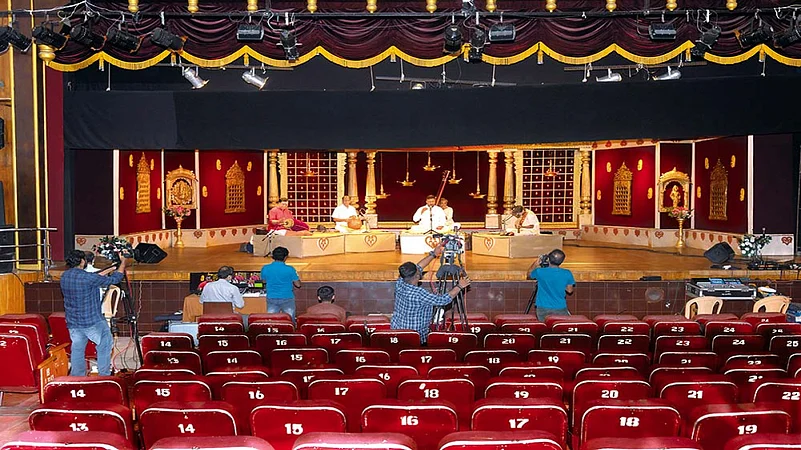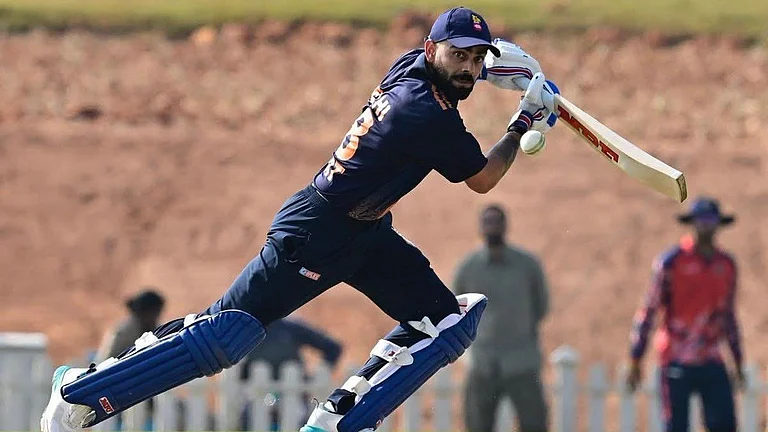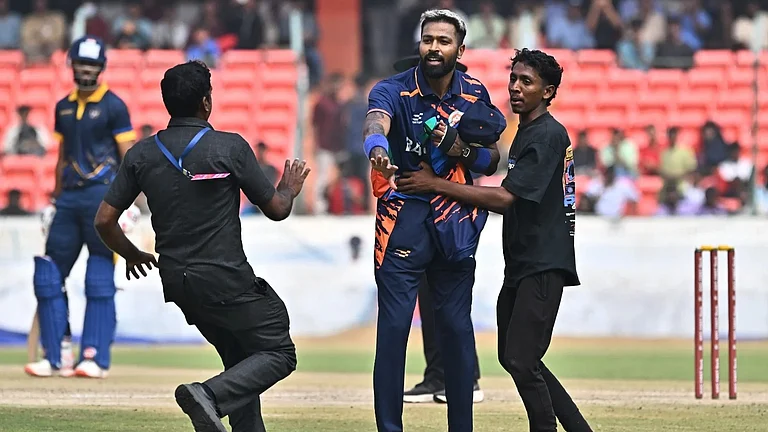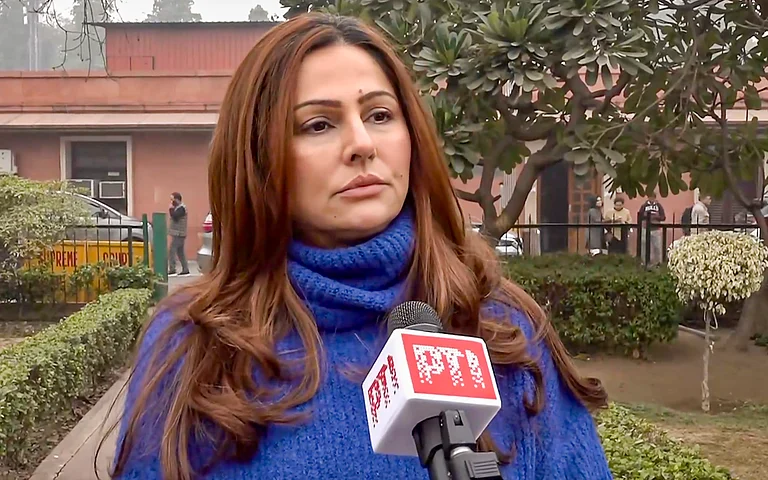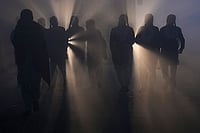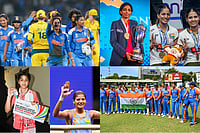The long Tamil Nadu summer slakes its thirst in the bounteous offerings of the northeast monsoon; pale, blue skies and milder days presage a cooler season. Around this time, Chennai is drenched by the notes and ragams of the annual Margazhi festival, or the Chennai music season. For the last two years, Carnatic vocalist Sanjay Subrahmanyan had been kickstarting his December music season with back-to-back concerts titled Tamizhum Naanum (Tamil and I). Running to nearly seven hours over two evenings and featuring Tamil compositions, the concert at Chennai’s Music Academy auditorium ran to a packed audience. Sanjay sang in his evocative, energetic style, affirming his status as a modern-day Carnatic maestro. He would follow the two shows with a dozen three-hour concerts during the Margazhi (Tamil month from Dec 15 to Jan 15) season, culminating in a four-hour concert on New Year’s morning.
But this December, when Sanjay (52) presented his 2020 edition of Tamizhum Naanum, he did so from the confines of a recording studio near his south Chennai residence. With him were his regular wingmen, S. Vardarajan on the violin and Neyveli Venkatesh on the mridangam. Even the second percussionist, usually a kanjeera player, was dispensed with. The three-hour concert, recorded in November, had been trimmed to just 90 minutes. The non-ticketed concert was streamed on December 12 and subsequently over the next two days. In spite of the usual rigour of the trio, Covid compulsions had pushed them to perform from the staid, stark environs of a studio. Even a digitally projected background failed to convey the brisk bustle that accompanies a Sanjay ‘kutcheri’.
“The other three concerts we recorded with Sanjay happened in concert halls, without audiences. We had to perform imagining a live audience, when there were only empty chairs. As performers, we are so used to feeding on instant appreciation, the sustained applause and the interjections of ‘bhesh’ that it was strange singing to empty chairs,” recalls violinist Varadarajan. To compensate for an appreciative audience, the three artistes took it upon themselves to act as each other’s rasikas during the concerts.
Thus, on-stage chemistry became the main energy boosters. “I was fortunate to have two senior vidwans—Mysore Shrikanth on the violin and Umayalpuram Sivaraman on mridangam—accompanying me. Our wonderful rapport enhanced the concert recording experience. We did a one-shot recording, as though it was a live concert, so that listeners would have the same experience, what with accompanying improvisations and imperfections, if any,” singer Sandeep Narayan says about his audience-less performance.

Vocalist Ramakrishnan Murthy performs at a concert in a picturesque setting for Madrasana.
Chennai’s bustling, crowded music season has been whittled down by the pandemic to such an extent that where there used to be nearly 70 sabhas (organisers) hosting over 1,000 events that included concerts, dance recitals, dance-dramas, Harikathas (musical storytelling), and Tamil plays, there are only two major players now--the venerable Music Academy and The Federation of City Sabhas. The latter, a congregation of 12 sabhas, is hosting and streaming the concerts from a single platform, ‘Yours Truly, Margazhi’ (YTM). With artistes unwilling to move between numerous halls and sabhas strapped for funds in the absence of regular sponsors, the joint venture made sense.
“We could not let Margazhi pass by…. And doing it together made economic sense as all the sabhas are cash-strapped, since they could not rent out their halls due to lack of events. This unity is also needed to support artistes and those who are part of the support system around dance programmes and plays. Hence we are charging a fee to subscribe to the events,” points out K. Harishankar, secretary of Narada Gana Sabha, the anchor sabha for YTM.
While the federation has charted out a month-long schedule from December 15 comprising concerts, dance recitals and plays, the Music Academy has drastically truncated its line-up. The 93-year-old institution pioneered the concept of a music festival since 1927 and has never skipped its annual event in spite of tragedies like MGR’s death in December 1987, the 2004 tsunami and Jayalalitha’s demise. But the pandemic prompted uncertainty about hosting events in its hallowed hall, forcing the Academy to cut its 18-day, 83-concert schedule to just eight days and 27 concerts. The weeklong dance festival was sacrificed, so was the annual awards ceremony.
“Though auditoriums were allowed to be opened from November end, how can we pick just 200 members (the permitted number) from our 1,400 members? How many tickets can we sell? How will artists feel honoured unless they are given awards in the physical presence of their fans and peers?” asks Music Academy president N. Murali. Streaming digitally, the academy has stuck to its tradition of free concerts of junior singers, while ticketing them for seniors.
Performers, too, are grappling with this year’s warped reality. Varadarajan, who used to play in over 25 concerts is down to 12. Star performers like Sanjay, Ranjani-Gayatri, Sudha Raghunathan and others have just four concerts. In the past, they had to struggle to cope with the crush of at least a dozen outings each.
While the digital experience is a first for stodgy senior sabhas, younger players are nimble-footed. Charsur Arts Foundation, in spite of hosting its annual events in concert halls, has had a parallel Youtube channel to showcase its clips from them. And Madrasana, famously, started as a digital-only player and later diversified to different concert stages like gardens, even cinema halls, to expand the kutcheri experience to newer audiences.
“During the lockdown we organised concerts where artistes performed remotely and we put it together as a unified concert using technology. Here, we only had to record the concerts at carefully-chosen locales.... Our experience with 3D cameras came in handy,” says Mahesh Venkateswaran of Madrasana.
The rasikas, though, felt short-changed as they were presented with fewer concerts, but stiff ticket prices. “My wife and I attended all of Sanjay Subrahmanyam’s 13 concerts last year. This year, we have to settle for just three paid concerts of just 90 minutes each, compared to the normal three hours. We are getting less of our favourite artiste, but have to pay more,” complains Shankar Subramaniam. But Harishankar points out that with many sponsors keeping away, the sabhas had to depend only on ticket prices to cover costs. And if the brisk ticket sale is any indication, most enthusiasts aren’t complaining, he observes.
Everyone, however, concurs that digital transmission of the concerts has one positive spin-off: it would widen the audience for Carnatic music and the reach of Chennai’s annual Margazhi festival would span the globe. “While Carnatic music lovers elsewhere in the world would happily log in, we could also get new converts as the music season will find new global audiences,” observes N. Murali. If that happens, he is even open to settle for a happy hybrid of the regular auditorium concert and its digital presentation in coming years.






